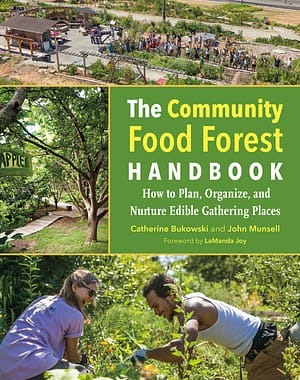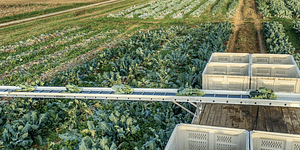Food Forests: What is a Community Food Forest?

The recent rise of community food forests and similar projects have come at an imperative time. More than 80 percent of the US population now resides in urban areas. This number is projected to rise in the next few decades.
Not only can food forests provide a local source of food they can also serve as perfect platforms for community-building in a social sense. Creating positive environmental and social change can start in the heart of any city with the implementation of a community food forest.
The following primer on community food forests is an excerpt from The Community Food Forest Handbook by Catherine Bukowski and John Munsell. It has been adapted for the web.
What Are Food Forests?
An on-the-ground, physical food forest mimics the spatial and functional patterns of a naturally occurring forest ecosystem.
Most people think of a forest as a large area, but from a biological standpoint a forest does not have to meet a minimum height or size requirement.
Rather, the term food forest signifies a highly integrated community of plants that has various vertical and horizontal plant and root layers that provide edible products.
Modeling the structure of a young forest ecosystem in public places is ideal for two reasons.
First, planting multiple perennial species in close proximity can sustainably yield food in confined areas, which can help meet the growing global demand for nutritious production.
Second, as the vegetation matures, it can create a forested parklike setting, providing a pleasing natural space where community members can gather.
Even if food production in a community food forest decreases, the forest still provides valuable green space in built environments.
Why Community Food Forests?
More than 80 percent of the US population now resides in urban areas. This number is projected to rise in the next few decades.
Finding ways to maximize use of existing open space is imperative, and increasing access to food through sustainable management of edible landscaping is one important approach among many that are underway.
Community food forests have great potential in this regard because they serve multiple functions on one piece of land. This aspect makes them desirable alternatives to traditional manicured park landscapes.
The growth of food forests is similar to the growth of other local food movements such as farmers markets and community-supported agriculture (CSA) programs that serve urban areas.
All are experiencing an upward trend as communities explore ways to bring food production closer to, or back into, urban areas, increase access to fresh produce, and promote knowledge about where food comes from.
For example, registered CSAs were a rarity in the 1980s, but now nearly 13,000 farms market their produce through thousands of CSA programs across the United States. Farmers markets have experienced similar growth, jumping in number by over 400 percent since the mid-1990s. The relatively recent rise of community food forests suggests they may experience something akin to this growth in the future.

A large bee sculpture at the Beacon Food Forest in Seattle calls attention to the importance of habitat and forage for pollinator species. The composting bins nearby are creatively designed in the shape of a honeycomb. These artistic site elements provide talking points that can help people learn about how food forests support pollinators.
One of the most powerful outcomes of a community food forest is education.
A community food forest can be used to help people learn about ecology, sustainable food production, food literacy, and engagement in community initiatives, as well as introduce them to cultural practices such as foraging, gleaning, and growing perennials.
It also can be a venue for social learning where people meet and take care of each other, build foundations for a shared economy, create abundance in their community, and find actionable ways to take part in forming a resilient society.
Food literacy is a key lesson of community food forests. Community food forests introduce people to a wide variety of food-producing plants and improve their ability to identify and harvest them.
Over time, this can change perceptions of acceptable and desirable food sources in a community. In community food forests, people often try fruits and nuts they were completely unaware of, such as pawpaws, elderberry, aronia, and hazelnuts.
Though this new awareness may seem small or insignificant, it is evidence of change. As community food forests mature and evolve, the larger and lasting goals espoused by many initiatives are likely to take root. (The appendix on page 231 lists mission statements and goals from community food forests.)
Community food forests address environmental justice when a participatory planning process is used that engages all members in site design and social activities, which define how public land should be used to serve their community.
After food forests are established, they provide a natural setting for personal and community enjoyment in ways defined by those who use it. When designed with public spaces in mind, they contribute to neighborhood aesthetics by providing green space and shaded areas in which to relax as well as to engage in recreational activities such as gardening or walking.
Additionally, they provide environmental services and benefits such as storm water management, biodiverse habitat (especially for birds, pollinators, and other small fauna), and healthy soil.
Community food forests contribute to civic and environmental resiliency when seed banks are planned into their purpose and trees are selected for preserving genetic material for vegetative propagation.
Sites can be libraries of regionally appropriate, climate-acclimated seed and propagation material for families, homesteads, and local farmers.
A community food forest at any scale can enhance ecosystem health, but it is important to consider carefully which environmental objectives are realistic to pursue given the size of a project.
Social Design for Community Support
Food forest design is well understood from a biological standpoint. Many websites, books, and other publications describe how to assess a site, design for uses of space, and group species together by function and purpose.
However, their focus is typically on private property, where the forest caretaker is a single person or a family. Dynamics change at the community scale. Food forests by themselves can be complex, but they become even more so when they are community supported.
The term community food forest is useful because it captures both the physical and social components of these projects. Community food forests serve local people while also propagating food-producing trees and shrubs, edible fungi, and medicinal plants, as well as providing environmental services and aesthetic experiences.
These projects are also a pivot point where environmental aims and the ethical and cultural foundations of human community can be combined and expressed through the design of a perennial plant community.
Community food forest design must consider how plant species change over time due to natural succession. Some plants will find their niche and others will fail. Having more than one plant fulfill multiple functions in the overall design builds resiliency into the system.
Similarly, there will be a natural turnover of people involved in a community food forest.
The number and names of the members, organizations, and agencies may change, but transparency and documentation throughout the process is crucial for the project to survive over time. By keeping communication open and active, participants can anticipate and guide such changes.
This will allow the food forest to grow positively and meet evolving conditions, needs, and values.

Gathering places at community food forests provide space for visitors to comfortably spend time on site and share experiences together. These social spaces do not have to be large or expensive, as the example here from the Mercy Edible Park in Philadelphia, Pennsylvania shows. Brainstorming creative ways to make the space out of locally available resources is an activity in and of itself which can bring volunteers together.
The manner in which a food forest is integrated into the fabric of a community is at least as important as the trees that are planted and the food that is produced.
How do people come together to decide on a cohesive design? How do they care for a site in the crucial beginning years when plants are establishing? What should they think about and initially do to ensure the longevity and success of a food forest that is open to the public?
A community food forest is a new model for communally growing food in the United States, and the answers to such questions are not well understood.
Insight and needs vary from community to community, and we turn to key examples from our research work and our own experience running a community food forest to identify common threads.
Encouraging local and diverse involvement early on is key to the success of a community food forest. Staying flexible and working together is central to planning and maintenance of the site, as well as to the people and relationships involved.
Community food forests that embrace a grassroots approach are typically the most successful, because participants gain a sense of pride and ownership in the project. Stakeholders come together and create a shared vision, acquire land, and navigate local policy.
They build sweat equity. A milestone is met when they break ground together. Another is accomplished when food is produced and community is celebrated.
Hazelwood was one of the first community food forests we visited while researching this book. One of our goals was to learn about the important community issues and values motivating the development of these projects.
We also studied what role these play in shaping project planning and maintenance. Information was collected at thirty community food forests across the country.
For the purposes of this book, we focused on forests open to the public and therefore did not include those located on college or university campuses. Although they are equally important, they also have very different social dynamics, with a continuous flow of new volunteers who regularly come and go.
Students may even be required through coursework to participate. Community orchards consisting only of fruit trees were also omitted, because we wanted to learn from projects that intentionally mimic a forest ecosystem by planting three or more layers of vegetation.
What we found is that successful projects involve complex community collaboration. They combine local expertise, insights, and interests to examine civic issues and define project goals and practices.
Our findings show that community food forests serve their immediate communities and larger town or city population in many ways, but long-term success is challenging. For instance, after visiting the Hazelwood Food Forest and meeting with site leaders, we learned that the property lease had been lost.
The nonprofit community development corporation that managed the site lease did not renew the contract in favor of a local start-up business that had support from the Heinz Endowments, a major philanthropic foundation.
As part of the revitalization efforts that ensued, the Hazelwood forest was replaced with a gravel parking lot and, ironically, a small plant nursery business.
Recommended Reads
Agroforestry Versus Permaculture: Which Approach to Use for a Community Food Forest
Recent Articles
Nothing says “spring” like a fresh, foraged meal! Savor the flavors of the season with this Milkweed Bud Pizza recipe.
Read MoreOxeye daisies are one of the most important plants for pollinators including beetles, ants, and moths that use oxeye daisies as a source of pollen and nectar. Instead of thinking about removing a plant like oxeye daisy, consider how you can improve the fertility and diversity of habitat resources in your home landscape, garden, or…
Read MoreSo you want to start reaping your harvest, but you’re not sure where to start? Learn how to break down the options of harvesting tools!
Read MoreWhat’s so great about oyster mushrooms? First, you can add them to the list of foods that can be grown indoors! They are tasty, easy to grow, multiply fast, and they love a variety of substrates, making oyster mushrooms the premium choice. The following is an excerpt from Fresh Food from Small Spaces by R. J.…
Read More









